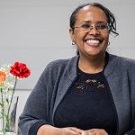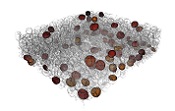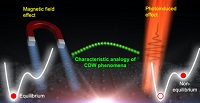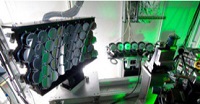
Message from the Office of Science Director Dr. Asmeret Asefaw Berhe

It is an honor to introduce myself to the Office of Science laboratory community. I’m ready and excited to pour my energy into making sure that we continue to be the world class, powerhouse science agency we have always been, and the steward of the research crown jewels that our labs represent. My first and foundational goal is to support, enable, and advocate for the work you all do to realize our shared vision: to support the best science across the full breadth of our world-leading portfolio of curiosity-driven and use-inspired basic research and to deliver the scientific tools the world needs to enable new discoveries. Together, I know we will make meaningful contributions to advancing our mission of scientific discovery by supporting our current workforce, and by developing a diverse and inclusive next generation of scientists to carry our SC mission into the future. Read more...
Science Highlights
Shedding New Light on the Study on High-Tc Cuprates – Contact: Jun-Sik Lee (SSRL)
In the ongoing quest for a room-temperature superconductor, scientists are examining the normal, or ground, state of the highest temperature superconductors currently known. It is thought that understanding the particularities of the normal state in these materials, for example the mysterious pseudogap phase, would give clues to how to engineer materials that can lead to superconducting behavior at even higher temperatures. When studying the normal state, especially its ground state, the superconducting state needs to be quenched; otherwise it will interfere. Two established methods for quenching the superconducting state are applying an external magnetic field and using an optical pump, but the relationship between the states achieved by these two methods is unclear. Read more...
Citation: Hoyoung Jang et al., Science Advances, 9 Feb 2022 (10.1126/sciadv.abk0832)
See also: Study raises new possibilities for triggering room-temperature superconductivity with light by Glennda Chui
Hunting the Spectroscopic Signature of Tc in Cuprate Superconductors – Contacts: Makoto Hashimoto, Donghui Lu (SSRL), Sudi Chen and Zhi-Xun Shen (SIMES/Stanford University)
An unconventional class of superconducting materials was discovered 35 years ago. These cuprates conducted electricity with no resistance or loss when chilled below a certain point – but at much higher temperatures than scientists had thought possible. This raised hopes of getting them to work at close to room temperature for perfectly efficient power lines and other uses. Research quickly confirmed that they showed two more classic traits of the transition to a superconducting state: As superconductivity developed, the material expelled magnetic fields, so that a magnet placed on a chunk of the material would levitate above the surface. Its heat capacity – the amount of heat needed to raise their temperature by a given amount – showed a distinctive anomaly at the transition. Despite decades of effort with a variety of experimental tools, the fourth signature, which can be seen only on a microscopic scale, remained elusive. Read more...
Citation: Su-Di Chen et al., Nature, 26 January 2022 (10.1038/s41586-021-04251-2)
See also: SLAC and Stanford researchers reveal the fourth signature of the superconducting transition in cuprates by Glennda Chui
Powerful X-rays Explore the Molecular Composition in a Historical Collection of Australian Plant Resins – Contacts: Uwe Bergmann (UW-Madison) and Dimosthenis Sokaras (SSRL)
A collection of native Australian plant resins sampled over one hundred years ago serves as a time capsule for scientists to study using modern techniques. The well-annotated and well-preserved samples by unknown collectors feature four species important to Aboriginal Australian technology and culture going back tens of thousands of years. A team of scientists employed advanced x-ray spectroscopy to decipher the molecular composition of this unique collection of samples. The researchers used SSRL and the Synchrotron Soleil to carry out x-ray Raman scattering (XRS) experiments to characterize the carbon and oxygen molecular structure. Read more...
Citation: Rafaella Georgiou et al. PNAS, 26 May 2022 (10.1073/pnas.2116021119)
See also: Researchers aim X-rays at century-old plant secretions for insight into Aboriginal Australian cultural heritage by David Krause
More SSRL-Related Science
What Drives Rechargeable Battery Decay? Depends on How Many Times You've Charged It
Excerpt from SLAC News Article by Nathan Collins

Rechargeable lithium-ion batteries do not last forever – after enough cycles of charging and recharging, they will eventually fail, so researchers are constantly looking for ways to squeeze a little more life out of their battery designs.
Now, researchers at SSRL and the Machine Learning Initiative at SLAC together with colleagues from Purdue University, Virginia Tech, and the ESRF have discovered that the factors behind battery decay actually change over time. Read more...
Citation: Jizhou Li et al., Science, 29 April 2022 (10.1126/science.abm8962)
Toward a Diffraction Limited Storage-Ring-Based X-ray Source
SLAC accelerator physicist Pantaleo Raimondi recently presented a webinar about the latest progress towards an ultimate x-ray source based on hybrid multi-bend achromats (MBA). MBA lattices have initiated a fourth generation for storage-ring light sources with orders of magnitude increase in brightness and transverse coherence. A few MBA rings have been built, and many others are in design or construction worldwide. See more...
Structural Biologists Reveal what Makes COVID-19 Antibody so Potent
Excerpt from Scripps Research Newsletter

After screening for antibodies against SARS-CoV-2 from the blood of COVID-19 survivors, scientists have visualized exactly how a specific antibody binds to different variants of the virus. The molecular mapping explains what makes the monoclonal antibody so powerful and could help the engineering of new and effective immune therapies against COVID-19. Learn more...
Citation: Jonathan L. Torres et al., PNAS, 12 May 2022 (10.1073/pnas.2120976119)
Piero Pianetta Shares 1st Light Experience

In recognition of 75 Years of Synchrotron Light, Lightsources.org encouraged users to share their first light experiences. SSRL Deputy Director Piero Pianetta shared this image of first light from the SPEAR Ring at SLAC on July 6, 1973. Piero wrote: “Pilot project to extract synchrotron radiation from the SPEAR ring at SLAC. In-alcove video camera imaging light emitted from a fluorescent screen just downstream of the Be exit window. No beam steering beyond global steering for colliding beam operation. Our group, including Gerry Fisher, waiting to see if beam would even make it through all the apertures. SUCCESS on first opening of line!!!!!” See #My1stLight campaign at Lightsources.org
Honors and Awards
Yi Cui is among the 120 newly elected members of the National Academy of Sciences. He is director of the Precourt Institute for Energy, Fortinet Founders Professor, professor of materials science and engineering and a member of the SSRL user community. He studies nanoscience to enable clean energy and sustainability technologies. He is known for his seminal contributions on inventing breakthrough battery technologies for electric transportation and for storing renewable energy. He also has broad contributions on solar energy conversion, carbon-free hydrogen generation, cooling and warming textile, water and air filtration, and cryogenic electron microscopy for materials science.
Diana Gamzina, a staff scientist at SSRL and founder of Elve, has been recognized with the IEEE Vacuum Electronics Young Scientist Award. Diana’s research involves development of advanced materials for vacuum electron devices and enabling miniaturization of accelerators and RF sources. Her expertise includes mechanics of materials’ interaction with electromagnetic waves, micro to nano scale as well as additive material synthesis techniques, high current density nano-composite cathodes, multiscale thermo-mechanical design and analysis, and development of compact high frequency RF sources.
Events
SSRL/LCLS Users' Meeting, SLAC, September 26–30, 2022, Menlo Park, CA — Save the Date
Our Annual Users' Meeting is a unique opportunity to gather together the light source community in a scientific event that includes numerous workshops, plenary presentations and poster sessions. An in-person event is planned this year. Participants can learn about current/future facility capabilities and the latest user research and discuss science with colleagues from academia, research laboratories, and industry worldwide. Registration is coming soon!
ULITIMA 2022 - Ultrafast Imaging and Tracking Instrumentation, Methods and Applications Conference, SLAC, October 3–6, 2022
Abstract submission is open until June 24 for the ULITIMA 2022 - Ultrafast Imaging and Tracking Instrumentation, Methods and Applications Conference, October 3–6, 2022. ULITIMA 2022 website
Announcements
Submit Nominations for the SSRL Users’ Executive Committee by September 4
We welcome candidates interested in standing for election to the SSRL Users Executive Committee (UEC). The SSRL UEC provides an organized framework for interaction between the SSRL scientific user community and SSRL Management. We are currently seeking nominations from the Environmental/Geosciences, Biospectroscopy/BIO SAXS and Macromolecular Crystallography communities. The SSRL UEC meets periodically throughout the year to plan the Users' Meeting in coordination with the LCLS UEC, select recipients for several awards, provide input to SSRL management on topics of interest to the user community, and to raise awareness about SSRL capabilities, user science and accomplishments to a broader audience. UEC elections are held annually in conjunction with our Users' Meeting. Nomination form
Call for SSRL Award Nominations
Recognize outstanding achievements of your colleagues, postdocs, students (or yourself) by submitting nominations for the following awards by the posted deadlines. These awards will be presented at the SSRL/LCLS Users’ Meeting planned for September 26–30, 2022. The recipients of the Klein and Spicer awards will be asked to present their research during the plenary session. Send nomination packages to Cathy Knotts.
William E. and Diane M. Spicer Young Investigator Award — Submit Nominations by JULY 1: The $1,000 Spicer Young Investigator Award honors the professional and personal contributions that William E. and Diane M. Spicer made to our community. Submit nomination packages including a letter summarizing the scientific contributions of the candidate as well as their CV and publications (supporting letters are also encouraged).
Melvin P. Klein Scientific Development Award — Submit Nominations by AUGUST 1: This $1,000 award honoring Mel Klein's many contributions recognizes research accomplishments of undergraduate/graduate students or postdoctoral fellows within three years of receiving their Ph.D. This award provides peer recognition and helps to promote dissemination of results based on work performed at SSRL. The nomination package should include the candidate’s CV, letters of recommendation from the advisor and colleagues, as well as an abstract written by the candidate describing the SSRL related experiments, scientific results, and plans to present the findings.
Farrel W. Lytle Award — Submit Nominations by AUGUST 5: The $1,000 Lytle Award was established to promote technical or scientific accomplishments in synchrotron radiation-based science and to foster collaboration and efficient use of beam time at SSRL. SSRL users and staff are eligible to be nominated for the Lytle Award. Letters of nominations should include a summary of the individual's contributions and why they should be recognized through this award. Supporting letters are welcome.
Postdoctoral Opportunities at SSRL
SSRL scientists are looking for a post-doctoral candidate for the position listed below - find out more about the opportunities at Careers at SLAC.
- Study of Quantum Materials through Resonant X-ray Scattering
User Research Administration
Beam Time Requests
- Xray / VUV - August 1, 2022 (Oct–Jan cycle)
- Macromolecular Crystallography - September 1, 2022 (Oct–Feb cycle)
Proposal Deadlines
- Macromolecular Crystallography - July 1, 2022
- Xray / VUV - August 1, 2022
- CryoEM biology-related proposals for the S2C2 program are due on the first day of each month and are being reviewed on a monthly basis.
Submit beam time requests and proposals through the User Portal.
The Stanford Synchrotron Radiation Lightsource (SSRL) is a third-generation light source producing extremely bright x-rays for basic and applied research. SSRL attracts and supports scientists from around the world who use its state-of-the-art capabilities to make discoveries that benefit society. SSRL, a U.S. DOE Office of Science national user facility, is a Directorate of SLAC National Accelerator Laboratory, operated by Stanford University for the U.S. Department of Energy Office of Science. The SSRL Structural Molecular Biology Program is supported by the DOE Office of Biological and Environmental Research, and by the National Institutes of Health, National Institute of General Medical Sciences. For more information about SSRL science, operations and schedules, visit http://www-ssrl.slac.stanford.edu.
To unsubscribe from SSRL Headlines, just send an e-mail to listserv@slac.stanford.edu with "signoff ssrl-headlines" in the body.
To subscribe, send an e-mail to with "subscribe ssrl-headlines" in the body.
Questions? Comments? Contact Lisa Dunn







